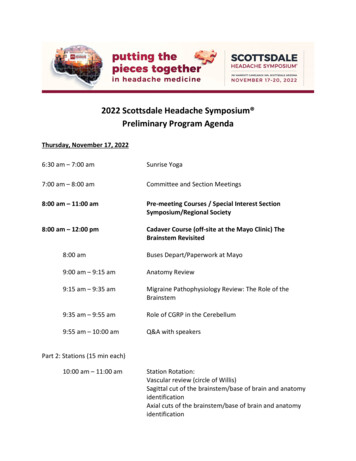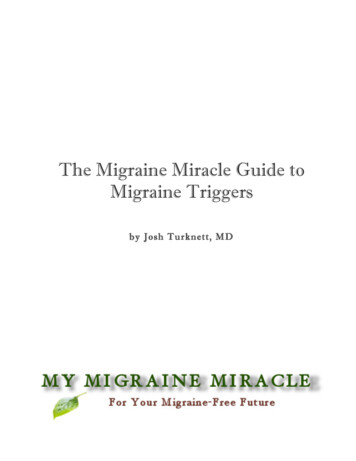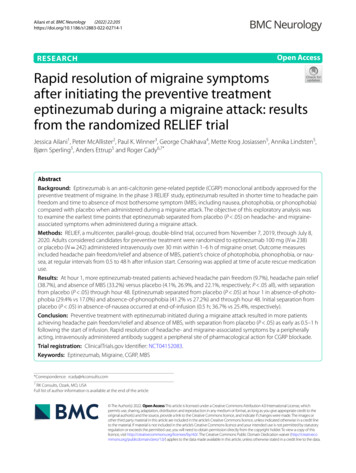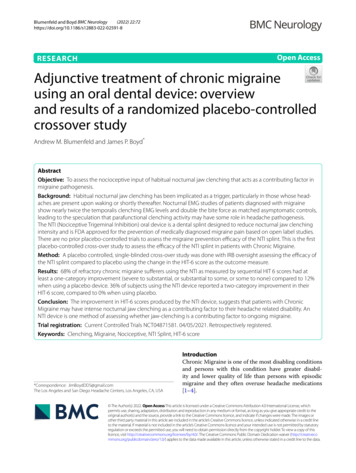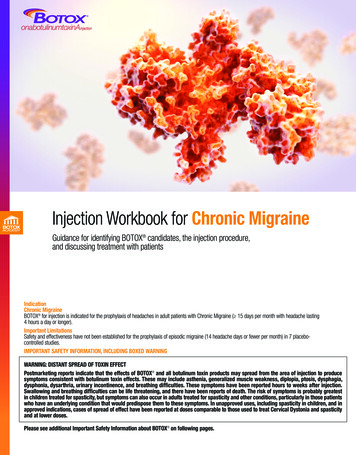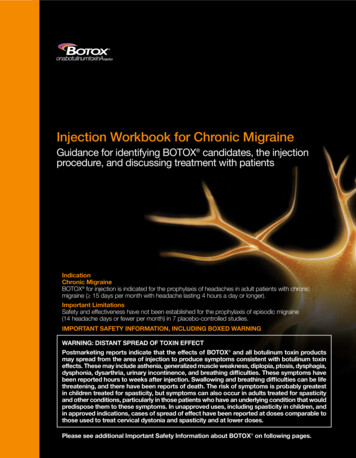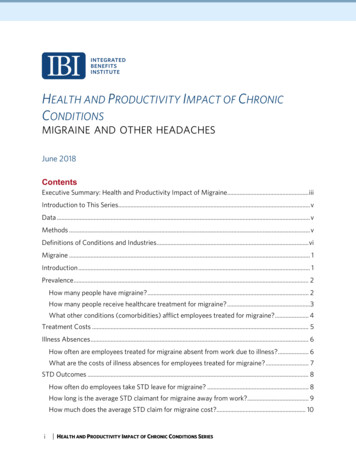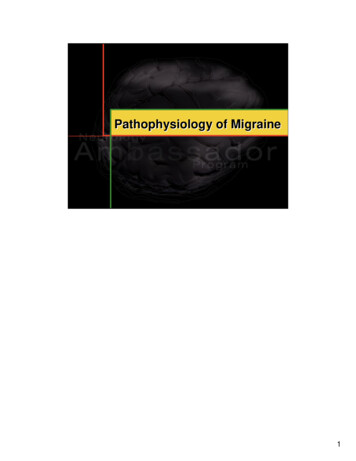
Transcription
Pathophysiology of Migraine1
MIGRAINE PATHOPHYSIOLOGY:A NEUROVASCULAR HEADACHEObjectivesReview the neurobiology of migraine- Features of acute attack- neuroanatomical substratesDiscuss the current understanding of migraine,vulnerability, initiation and activation of thetrigeminocervical pain systemDescribe the modulation of head pain in the CNS2
WHAT IS MIGRAINE?Neurobiologically based, common clinicalsyndrome characterized by recurrent episodicattacks of head pain which serve no protectivepurposeThe headache is accompanied by associatedsymptoms such as nausea, sensitivity to light,sound, or head movementThe vulnerability to migraine if for many, aninherited tendencyMigraine is a complex neurobiological disorder that has been recognized since antiquity. Manycurrent books cover the subject in great detail.The core features of migraine are headache, which is usually throbbing and often unilateral, andassociated features of nausea, sensitivity to light, sound, and exacerbation with head movement.Migraine has long been regarded as a vascular disorder because of the throbbing nature of thepain. However, as we shall explore here, vascular changes do not provide sufficient explanationof the pathophysiology of migraine. Up to one-third of patients do not have throbbing pain.Modern imaging has demonstrated that vascular changes are not linked to pain and diameterchanges are not linked with treatment.This presentation aims to demonstrate that: Migraine should be regarded as neurovascular headache. Understanding the anatomy and physiology of migraine can enrich clinical practice.Lance JW, Goadsby PJ. Mechanism and Management of Headache. London, England: Butterworth-Heinemann;1998.Silberstein SD, Lipton RB, Goadsby PJ. Headache in Clinical Practice. 2nd ed. London, England: Martin Dunitz;2002.Olesen J, Tfelt-Hansen P, Welch KMA. The Headaches. 2nd ed. Philadelphia, PA: Lippincott Williams & Wilkins;2000.3
MIGRAINE PATHOPHYSIOLOGYNeuroanatomical correlatesof the migraine attackVulnerability to migraineTriggering migraineMigraine auraMigraine painThe frequency with which migraine attacks occur may vary from once in a lifetimeto almost daily, an indication that the degree of migraine predisposition variesindividually. Our current concept is of a threshold of susceptibility.To understand migraine, we need to consider both the factors that influence thethreshold of a person’s susceptibility to a migraine attack and also the mechanismsthat trigger the attack and the associated symptoms. Theories about pathophysiologymust be based on the anatomy and physiology of the pain-producing structureswithin the cranium.First we will consider the neuroanatomical structure underlying the migrainesyndrome. Next we will discuss the genetic basis of vulnerability to migraine andthe functional consequences of inheriting migrainous genes, which might be called a“sensitive brain.”We will also talk about the triggers for migraine, how these explain aspects of thedisorder, and how this knowledge translates into practical, rational, lifestyle advicewhen planning treatment.We shall consider our current understanding of the migraine aura, migraine pain andfeatures of the acute attack.4
CLINICAL PHASES OF AMIGRAINE ATTACKAttack InitiationVulnerabilityProdrome AuraHeadachePostdromeTimeBlau JN. Lancet. 1992Acute migraine attacks occur in the context of an individual’s inherent level ofvulnerability. The greater the vulnerability or lower the threshold, the morefrequent attacks occur. Attacks are initiated when internal or environmental triggersare of sufficient intensity to activate a series of events which culminate in thegeneration of a migraine headache. We are all too familiar with the clinical phasesof a migraine attack. Many migraineurs experience vague vegetative or affectivesymptoms as much as 24 hours prior to the onset of a migraine attack. This phase iscalled the prodrome and should not be confused with the aura phase.The aura phase consists of focal neurological symptoms that persist up to one hour.Symptoms may include visual, sensory, or language disturbance as well assymptoms localizing to the brainstem.Within an hour of resolution of the aura symptoms, the typical migraine headacheusually appears with its unilateral throbbing pain and associated nausea, vomiting,photophobia, or phonophobia. Without treatment, the headache may persist for up to72 hours before ending in a resolution phase often characterized by deep sleep.For up to twenty-four hours after the spontaneous throbbing has resolved, manypatients may experience malaise, fatigue, and transient return of the head pain in asimilar location for a few seconds or minutes following coughing, sudden headmovement, or valsalva movements. This phase is sometimes called the migrainehangover.Blau JN. Migraine: theories of pathogenesis. Lancet. 1992;339:1202-1207.5
ACTIVATION OF TRIGEMINAL/CERVICAL AFFERENT NEURONSVulnerabilityAttack Initiation(Prodrome/Aura)PAINSomatosensory input to the head involves pseudounipolartrigeminal and upper cervical branchesInvestigations in migraine fall into three categories:1.Those focused on the vulnerability for an attack and the generation of theacute attack2.Those focused on activation of the trigeminal/cervical pain system, and3.Those examining the modulation of the painful activation within the CNS.This diagram summarizes the flow of nociceptive information into the CNS whenactivation occurs within primary afferent neurons.6
MIGRAINE PATHOPHYSIOLOGYNeuroanatomical correlatesVulnerability to migraineTriggering migraineMigraine auraMigraine painIt is becoming increasingly clear that much of the vulnerability to migraine isinherited.7
VULNERABILITY: GENETIC BASISTwin studies: MZ DZIon channelopathy –EXCITATIONFamilial hemiplegic migraine α1A subunit of the P/Q voltage-gatedCa2 channel on chromosome 19( 50% of cases) Mutation in gene ATP1A2 (encodesalpha2 subunit of Na /K pump)results in loss of function of singleATP1A2 allele (chromosome 1)SOUND Linked to regular migraineGenetically heterogeneousA strong familial influence in migraine has long been apparent and this has been demonstrated in twin studies. Theconcordance for migraine in monozygotic twins is greater than that for dizygotic twins (1). However, it is alsoclear that the genetic background is complex.The molecular genetic era for migraine was heralded by the identification of four different missense mutations inthe α1A subunit of the P/Q-type, voltage-gated calcium channel on chromosome 19 that is responsible for familialhemiplegic migraine (FHM) in some families (2). FHM is a rare subtype of migraine with aura that has a clearautosomal dominance inheritance pattern. A linkage to chromosome 19 also appears to occur in some families withmore usual migraine (3,4).De Fusco and colleagues (5) show that the gene ATP1A2, which encodes the alpha2 subunit of the Na /K pump, isassociated with familial hemiplegic migraine type 2 (FHM2) and is linked to chromosome 1q23. This mutationresults in a loss of function of a single allele of ATP1A2. This is the first report that associates a mutation in theNa /K pump to the genetics involved in migraine.Additionally, research suggests that variations within the dopamine D2 receptor gene also may have some affect onsusceptibility to migraine (6). Thus, genetic studies are providing important information about the molecular basisof migraine.1.Honkasalo ML, Kaprio J, Winter T, et al. Migraine and concomitant symptoms among 8167 adult twin pairs. Headache.1995;35:70-78.2.Ophoff RA, Terwindt GM, Vergouwe GM, et al. Familial hemiplegic migraine and episodic ataxia type-2 are caused bymutations in the Ca2 channel gene CACNL1A4. Cell.1996;87:543-552.3.May A, Ophoff, RA, Terwindt GM, et al. Familial hemiplegic migraine locus on chromosome 19p13 is involved in commonforms of migraine with and without aura. Hum Genet. 1995;96(5):604-608.4.Nyholt DR, Lea RA, Goadsby PJ, et al. Familial typical migraine: linkage to chromosome 19p13 and evidence for geneticheterogeneity. Neurology. 1998;50:1428-1432.5.De Fusco M, Marconi R, Silvestri L, et al. Haploinsufficiency of ATP1A2 encoding the Na /K pump alpha2 subunitassociated with familial hemiplegic migraine type 2. Nat Genet. 2003;33(2):192-196.6.Peroutka SJ, Wilhoit T, Jones K. Clinical susceptibility to migraine with aura is modified by dopamine D2 receptor (DRD2)NcoI alleles. Neurology. 1997;49:201-206.8
THE P/Q GENE PRODUCTOphoff RA et al. Cell. 1996.This diagram illustrates the four missense mutations in the a1subunit of the P/Q-type,voltage-gated calcium channel on chromosome 19 causing FHM in some families, as wellas mutations responsible for episodic ataxia type 2 (1). This discovery has importantimplications for the pathophysiology of migraine. Neuronal calcium channels mediateserotonin (5-HT) release within the midbrain (2).Therefore, dysfunction of these channels might impair serotonin release and predisposepatients to migraine or impair their self-aborting mechanism. The interactions ofmagnesium with calcium channels are also interesting in light of magnesium deficiency inthe cortex of migraine patients and the role of calcium channels in spreading depression,which may initiate migraine aura (3).1. Ophoff RA, Terwindt GM, Vergouwe GM, et al. Familial hemiplegic migraine and episodic ataxia type-2are caused by mutations in the Ca2 channel gene CACNL1A4. Cell. 1996;87(3):543-552.2. Yakhnitsa VA, Pilyavskii AI, Limansky YP, Bulgakova NV. Modulation of the activity of midbraincentral gray substance neurons by calcium channel agonists and antagonists in vitro. Neuroscience.1996;70(1):159-167.3. Ramadan NM, Halvorson H, Vande-Linde A, et al. Low brain magnesium in migraine. Headache.1989;29(9):590-593.9
MIGRAINE PATHOPHYSIOLOGYNeuroanatomical correlatesVulnerability to migraineTriggering migraineMigraine auraMigraine painSpreadingdepression?Given the genetic tendency to headache that results in a heightened sensitivity tostimuli of many types in people with migraine, how can we turn this into practicalinformation about avoiding headache triggers ?10
SPREADING DEPRESSION OFLEAOSilberstein SD et al. Headache in Clinical Practice. 2002; Leao AAP. J Neurophysiol. 1994.This EEG illustrates spreading depression moving across the cortex with theclassical slow progress and recovery first observed by Leao after noxiousstimulation of the exposed cerebral cortex of a rabbit (1). The rate of spread (3-6mm/min) is very characteristic. Also characteristic is the loss of normal response tohigh CO2, whereas normal response to changes in blood pressure are preserved (2).Illustration after Silberstein et al 2002 (3).1.Leao AAP. Spreading depression of activity in cerebral cortex. J Neurophysiol. 1944;7:359390.2.Lauritzen M. Pathophysiology of the migraine aura. The spreading depression theory. Brain.1994;117 (Pt 1):199-210.3.Silberstein SD, Lipton RB, Goadsby PJ. Headache in Clinical Practice. 2nd ed. London,England: Martin Dunitz; 2002.11
MIGRAINE AURAOnly 15% of patients experience the classical“slow march” of symptoms typified by migrainewith auraLashley calculated rate of expansion of his ownvisual scotoma to be 3 mm/minInitial hyperemia followed by oligemia spreadsfrom the occipital cortex at a rate of 2 – 6 mm/minHeadache usually starts while cerebral blood flowis diminishedLashley KS. Arch Neurol Psych. 1941. Olesen J et al. Ann Neurol. 1990.Woods RP. et al. N Engl J Med. 1994. Lauritzen M. Brain. 1994.The symptoms of migrainous aura are spectacular and sometimes frightening.Although most migraine patients will never have an aura, much attention has beenfocused on the phenomenon. The classical, slow progression of symptoms isexperienced by only 15%, whereas less specific disturbances cover the whole visualfield in about 25% of patients.Lashley calculated the rate of the characteristic slow march of symptoms to be 3mm/min (1). This corresponds to the rate of the spreading oligemia that has beenobserved in studies of cerebral blood flow during aura (2,3). A positron emissiontomography (PET) study of spontaneous migraine demonstrated a spreading,bilateral oligemia, which establishes that the phenomenon exists in migrainesufferers (4). It is interesting that headache starts when blood flow is still reduced(3), making it unlikely that vasodilatation is a cause of pain.1.Lashley KS. Patterns of cerebral integration indicated by the scotomas of migraine. ArchNeurol Psych. 1941;46:331-339.2.Lauritzen M. Pathophysiology of the migraine aura. The spreading depression theory.Brain. 1994;117(Pt 1):199-210.3.Olesen J, Friberg L, Olsen TS, et al. Timing and topography of cerebral blood flow, aura,and headache during migraine attacks. Ann Neurol. 1990;28(6):791-798.4.Woods RP, Iacoboni M, Mazziotta JC. Brief report: bilateral spreading cerebralhypoperfusion during spontaneous migraine headache. N Engl J Med. 1994;331(25):16891692.12
MIGRAINE AURA IS NEURONALHadjikhani N et al. Proc Natl Acad Sci USA. 2001.Hadjikhani and colleagues (1) were able to record induced and spontaneous migraine aura.They conclude that migraine aura is not evoked by ischemia. More likely, it is evoked byaberrant firing of neurons and related cellular elements characteristic of cortical spreadingdepression. Vascular changes follow changes in neuronal activity during the visual aura. It maybe that in patients who experience the aura, the neurophysiological events which result in thevisual or sensory symptoms also result in activation of trigeminal/cervical nociceptiveneurons. Future studies using similar techniques should clarify the correlation of the onset ofthe headache pain to better understand the relationship between cortical spreading depressionand pain.Shown is the entire hemisphere, from a posterior-medial view. The aura-related changesappeared first in extrastriate cortex. The spread of the aura began and was most systematic inthe representation of the lower visual field, becoming less regular as it progressed into therepresentation of the upper visual field.1. Hadjikhani N, Sanchez Del Rio M, Wu O, et al. Mechanisms of migraine aura revealed by functional MRIin human visual cortex. Proc Natl Acad Sci USA. 2001;98(8):4687-4692.13
IN PATIENTS WITH AURA, EVENTS INTRINSIC TOCORTEX MAY CAUSE ACTIVATION OF PRIMARYAFFERENT NEURONSMeningesNOAAK H adingal SpreCorticniossreDepTrigeminal rigeminalnucleusSuperiorsalivatorynucleusAdapted fromIadecola C. Nat Med 2002;Bolay H et al. Nat Med. 2002.The trigeminal nerve, which innervates the meninges, is intricately involved inmigraine. How the migraine is triggered and the cascade of events following theoriginal activation of migraine are not completely understood. However, there isincreasing evidence that events intrinsic to the cerebral cortex are capable ofaffecting the pain sensitive dural vascular structures. If this is the case, then thismight explain on way in which the headache is activated in individuals experiencingthe aura.Bolay and colleagues report that, in animal models of migraine, there is aconnection between cortical spreading depression (CSD) and activation oftrigeminal nerve afferents. Activation of the trigeminal nerve evokes a series ofmeningeal and brainstem events that appear to be consistent with what is seenduring a migraine attack.Specifically, triggering CSD leads to a long-lasting blood flow increase within themiddle meningeal artery. This increase in blood flow is dependent upon trigeminaland parasympathetic activation. In addition, plasma protein leakage occurres in thedura. This is the first study to specifically demonstrate that vasodilation duringheadache is possibly linked to a series of neurometabolic brain events, includingtransmission of pain via the trigeminal nerve.Bolay H. Reuter U, Dunn AK, Huang Z, Boas DA, Moskowitz MA. Intrinsic brain activity triggerstrigeminal meningeal afferents in a migraine model. Nat Med. 2002;8(2):136-142.Iadecola C. From CSD to headache: a long and winding road. Nat Med. 2002;8(2):110-112.14
MIGRAINE PATHOPHYSIOLOGYGenetic basisSensitive brainTriggering migraineMigraine auraMigraine painMigraine pain and the features of the acute attack have come under intense scrutinyin the last decade. Our enhanced understanding of the disease has been greatlyfacilitated by the development of new, specific, more effective, acute antimigrainetreatments.15
PAIN-PRODUCINGINTRACRANIAL STRUCTURESRay BS, Wolff HG. Arch Surg. 1940.The vascular theory of migraine pathogenesis that dominated thought inthe middle of the 20th century was based on three importantobservations: 1. The most important structures that register pain in thehead are the large cranial vessels, proximal cerebral vessels and duralarteries and the large veins and venous sinuses. These were identified byRay and Wolff during neurosurgery on awake patients using localanesthesia. 2. The longstanding observation that extracranial branchesof the carotid artery became engorged and pulsated during migraineattacks and 3. The most effective antimigraine drug, ergotamine was apotent vasoconstrictor.Ray BS, Wolff HG. Experimental studies on headache. Pain sensitive structures of the head and theirsignificance in headache. Arch Surg. 1940;41:813-856.Goadsby PJ. Pathophysiology of headache. In: Silberstein SD, Lipton RB, Dalessio DJ, eds. Wolff’sHeadache and Other Head Pain. 7th ed. New York, NY: Oxford University Press; 2001:57-72.16
MIGRAINE HEADACHE:HOW IS IT GENERATED?Involves abnormalactivation oftrigeminocervical afferentsORabnormal modulation oftrigeminocervical neuronsWeiller C et al. Nat Med. 1995.Our understanding of how the headache of migraine is initiated is a work in progress. There is evidence ofinappropriate activation of both primary afferent neurons and higher order neurons within the pain modulatorysystem. Any event that activates the system is capable of causing a headache.There is a report that supports a completely centrally driven activation. It has been recognized forsome time that certain aminergic brainstem nuclei, nucleus locus coeruleus, and dorsal raphe nucleuscan alter brain blood flow and are involved in nociceptive control, as well as other modulation ofother sensory modalities (1). Raskin and colleagues’ clinical observation that placing an electrodeinto the region of the periaqueductal grey matter can evoke a migraine-like headache (2) reinforcedexperimental animal findings that stimulation of the locus ceruleus reduces blood flow in afrequency-dependent manner (3). These findings allowed the development of the central neuralhypothesis of migraine (4)(5).1.2.3.4.5.Goadsby PJ, Lance JW. Brainstem effects on intra- and extracerebral circulations. Relation to migraineand cluster headache. In: Olesen J, Edvinsson L, eds. Basic Mechanisms of Headache. Amsterdam, TheNetherlands: Elsevier Science Publishers; 1988:413-427.Raskin NH, Hosobuchi Y, Lamb S. Headache may arise from perturbation of brain. Headache.1987;27(8):416-420.Goadsby PJ, Lambert GA, Lance JW. Differential effects on the internal and external carotid circulationof the monkey evoked by locus coeruleus stimulation. Brain Res. 1982;249(2):247-254.Goadsby PJ, Zagami AS, Lambert GA. Neural processing of craniovascular pain: a synthesis of thecentral structures involved in migraine. Headache. 1991;31(6):365-371.Weiller C, May A, Limmroth V, et al. Brainstem activation in spontaneous human migraine attacks. NatMed. 1995;1(7):658-660.17
THE NEUROVASCULAR THEORYGoadsby PJ et al. N Engl J Med. 2002.Migraine is a primary brain disorder most likely involving an ion channel in the aminergicbrain stem nuclei ( ), a form of neurovascular headache in which neural events result indilation of blood vessels aggravating the pain and resulting in further nerve activation. Itinvolves dysfunction of brain-stem pathways that normally modulate sensory input. Thekey pathway for the pain is the trigeminovascular input from the meningeal vessels. Thesenerves pass through the trigeminal ganglion and synapses on second-order neurons in thetrigeminocervical complex, which then project through the quintothalamic tract and, afterdecussating in the brain stem, form synapses with neurons in the thalamus.A reflex connection exists between neurons in the pons in the superior salivatory nucleus,which results in a cranial parasympathetic outflow that is mediated through thepterygopalatine, otic, and carotid ganglia. This trigeminal-autonomic reflex is present innormal persons but is expressed most strongly in patients with trigeminal-autonomiccephalgias, such as cluster headache and paroxysmal hemicrania. It may also be active inmigraine.Brain imaging studies suggest that important modulation of the trigeminovascularnociceptive input stems from dorsal midbrain, periaqueductal grey and the dorsal raphenucleus, and the pons, the locus coeruleus.Goadsby, PJ, Lipton RB, Ferrari, MD. Migraine. Current Understanding and Treatment. N Engl J Med2002;346:257-270. Copyright (C) 2002. Massachusetts Medical Society. All rights reserved.18
TRIGEMINAL NEUROPEPTIDES RELEASEDDURING MIGRAINE ATTACKS* p 0.05Goadsby PJ et al. Ann Neurol. 1990.This diagram illustrates the elevation of calcitonin-gene-related peptide (CGRP),but not substance P, in the external jugular venous blood of patients with acutemigraine with aura (MWA) and migraine without aura (MWOA) (1). In animalstudies SP, NKA and CGRP are all increased with stimulation of the trigeminalganglion.1.Goadsby PJ, Edvinsson L, Ekman R. Vasoactive peptide release in the extracerebralcirculation of humans during migraine headache. Ann Neurol. 1990;28:183-187.19
PERIPHERAL PROCESSING:STERILE NEUROGENIC INFLAMMATIONCutrer FM et al. Headache: Bluebooks of Practical Neurology. 1997.This diagram from Cutrer and colleagues illustrates the neurally-induced plasmaprotein extravasation model of trigeminal activation.Cutrer FM, Limmroth V, Woeber C, et al. New targets for antimigraine drug development. In:Goadsby PJ, Silberstein SD, eds. Headache: Bluebooks of Practical Neurology. Vol. 17.Philadelphia, PA: Butterworth-Heinemann; 1997:59-120.20
CENTRAL PROCESSING:CUTANEOUS minal SensitizationSensitization443-Forehead3-Forehead dyniaAllodynia2-Central2-Central tein R et al. Brain. 2000.Most migraine patients exhibit cutaneous allodynia inside and outside their painreferred areas during migraine attacks. Burstein and colleagues studied thedevelopment of cutaneous allodynia in migraine by measuring the pain thresholds inthe head and forearms of a patient at several points during the migraine attack (1, 2,and 4 hours after onset) and compared the pain thresholds in the absence of an attack.This study demonstrated that a few minutes after the initial activation of the patient’speripheral nociceptors, these became sensitized and mediated the symptoms of cranialhypersensitivity. The barrage of impulses then activated second-order neurons andinitiated their sensitization, mediating the development of cutaneous allodynia on theipsilateral head. The sensitized second-order neurons activated and eventuallysensitized third-order neurons leading to allodynia on the patients contralateral headand forearms by the two-hour point, a full hour after the initial allodynia on theipsilateral head.The authors concluded that this progression of symptoms calls for the early use ofantimigraine drugs that target peripheral nociceptors before central sensitizationoccurs.Burstein R, Cutrer MF, Yarnitsky D. The development of cutaneous allodynia during a migraine attack:clinical evidence for the sequential recruitment of spinal and supraspinal nociceptive neurons inmigraine. Brain. 2000;123 (Pt 8):1703-1709.21
CENTRAL SENSITIZATION:OCCURS SEQUENTIALLY OVER TIMEIn a spontaneous case of migraine with auranAllodynia not present interictallynAppeared in Ipsilateral face at 1 hournAppeared Contralateral face and Ipsilateral arm at2 hoursnIntensified in similar distribution at 4 hoursThis has therapeutic significance, implying sensitizationabove the TNC and a mechanistic rationale for earlytreatmentBurstein et al 2000In a spontaneous case of migraine with aura the evolution of changes in detailsensory testing was followed over time.Allodynia not present interictallyAppeared in Ipsilateral face at 1 hourAppeared Contralateral face and Ipsilateral arm at 2 hoursIntensified in similar distribution at 4 hoursThis has therapeutic significance, implying sensitization above the TNC and amechanistic rationale for early treatment22
MIGRAINE PATHOPHYSIOLOGY:OVERVIEWINITIATING EVENTACTIVATION &PROCESSING OFNOCICEPTIONBoth ProvideProvide TargetsTargets forfor TherapeuticTherapeutic InterventionInterventionBothGoadsby PJ et al. N Engl J Med. 2002.Migraine is a complex primary brain disorder that involves a cascade of events thatlead to recurrent inappropriate activations of the trigeminocervical pain system. Theinitiating events are currently the focus of study and may prove to be invaluable targetsfor future prophylactic treatments. The events involved in activation and processing ofthe nociceptive depolarization within the trigeminocervical pain system may providetherapeutic targets for acute and preventative treatments.Goadsby, PJ, Lipton RB, Ferrari, MD. Migraine. Current Understanding and Treatment. N Engl J Med2002;346:257-270. Copyright (C) 2002. Massachusetts Medical Society. All rights reserved.23
MIGRAINE PATHOPHYSIOLOGY:CONCLUSIONSMigraine is a neurovascular headacheMigraine has a significant genetic componentThe biology of migraine is increasingly wellunderstoodTreatment of migraine can be optimized andunderstood in terms of the anatomy andphysiology of the conditionIn conclusion, we have seen that migraine is a neurovascular headache. Asignificant genetic component to predisposition to migraine exists, and thefunctional consequences of the genetics are beginning to be explored. The biologyof migraine is better although not completely understood. This increasedunderstanding provide great opportunities to continue to improve treatment.24
1 subunit of the P/Q-type, voltage-gated calcium channel on chromosome 19 causing FHM in some families, as well as mutations responsible for episodic ataxia type 2 (1). This discovery has important implications for the pathophysiology of migraine. Neuronal calciumchannels mediate serotonin (5-HT) release within the midbrain (2).
